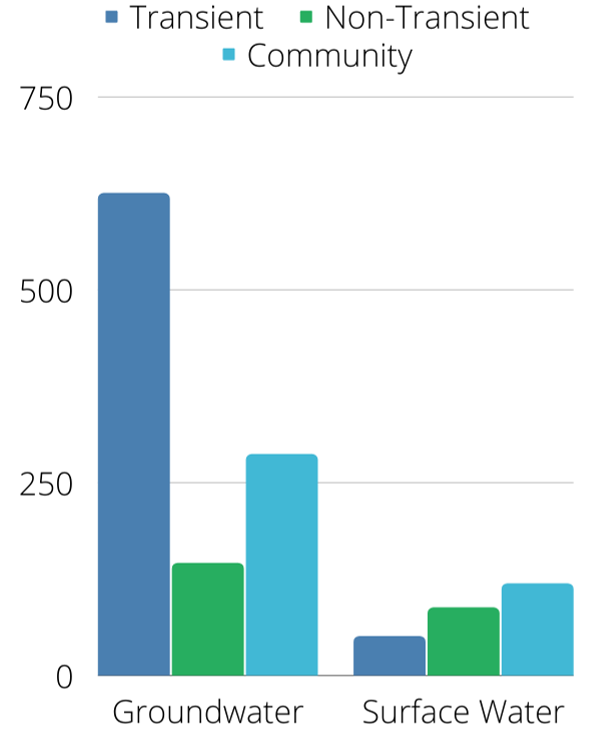DW Program Information
What is a public water system?
A Public Water System (PWS) supplies water to consumers and is NOT a private water system. There are different categories of PWS that supply water to consumers. Each category of systems has its own set of requirements that a PWS must meet.
- Community Water System
- Expects to serve, year-round, at least 25 individuals; or
- Expects to serve, year-round, at least 15 residential service connections
- Non-Transient Non-Community Water System (NTNCWS)
- Regularly serves the same 25 or more individuals for at least 6 months of the year
- Transient Non-Community Water System (TNCWS)
- Is not a CWS or NTNCWS; and
- Regularly serves at least 25 individuals each day for at least 60 days of the year
- Non- Public or Private Water System
- Serves less than 25 individuals each day and does not meet the requirements to be a public water system and is not regulated by the Drinking Water Program
Public Water Systems in Alaska

Find frequently asked questions, resources, and information to help you learn more about the water you drink.
Find helpful tips for drilling a new well, maintaining and your existing well, and protecting your groundwater.
General Drinking Water Information
The Alaska Department of Environmental Conservation, Division of Environmental Health, Drinking Water Program requires Public Water Systems (PWS) to be in compliance with the state drinking water regulations, in accordance with the Federal Safe Drinking Water Act and Amendments, for the public health protection of the residents and visitors to the State of Alaska.
Program Mission
The Drinking Water Program is responsible for requiring public water systems to supply safe drinking water for public consumption that meets minimum federal health-based standards, established by the Environmental Protection Agency as required by the federal Safe Drinking Water Act. Alaska has had primary enforcement responsibility of the Public Water System Supervision program since 1978. Engineering and Environmental Specialist staff provide guidance to the public water systems owners and operators on the design, installation, maintenance and operation of drinking water facilities. They review project descriptions and engineered plans for new and modified systems to ensure that appropriate standards are met to protect human health and minimize the impact to the environment. Staff also provide access to office files on local public drinking water systems, as well as technical and compliance assistance on regulatory, engineering, and drinking water public health-related issues.
Frequently Asked Questions
- What do the Drinking Water Regulations do?
- The drinking water regulations set the standards for safe drinking water, and they identify the regulated drinking water contaminants and the level of those contaminants allowed in the water. These contaminants could be harmful for those who drink the water, especially the elderly, children, or individuals with developing or compromised immune systems or that have immune deficiencies.
- What types of contaminants are regulated?
- The main contaminants regulated by the Drinking Water Program are:
- Bacteria, Viruses (from septic systems, etc) and parasitic protozoans
- Lead and Copper
- Nitrate and Nitrite (commonly from septic systems)
- Heavy Metals like Arsenic and Cadmium
- Volatile Organic Contaminants (VOC) like Benzene and gasoline
- Synthetic Organic Contaminants (SOC) like pesticides and herbicides
- How do water contaminants affect us?
- Consuming water containing contaminants above the established Maximum Contaminant Level (MCL) set by the regulations over a period of time could cause chronic (long term) or acute (short term) health problems.
- Where can I look up information on a public water system?
- Information about public water system can be found through Drinking Water Watch.
- Who can I contact if I have questions about a public water system?
- You can contact your water system directly or contact the Drinking Water Program office in your area.
- How can I get my private well tested?
- It's recommended that all samples be sent to a State of Alaska Certified Laboratory. A list of current laboratories certified by the State of Alaska can be viewed at the following pages:
- How can I disinfect my private well?
- Find instructions for disinfecting your well at the Private Drinking Water Wells & Systems page.
- What does the Drinking Water Program do?
- Primary Services of the Drinking Water Program
- Requires that public water system owners and operators monitor drinking water for regulated drinking water contaminants.
- Reviews contaminant monitoring results from public water suppliers and specify corrective measures where contamination is indicated.
- Approves new public water systems and modifications to existing ones.
- Regulates minimum health-based standards and procedures for design, construction and operation of Alaska's public drinking water systems.
- Implements a statewide drinking water compliance strategy to best assist Alaska water systems in providing safe drinking water.
- Provides information about contaminant monitoring and sampling procedures to public water system owners and operators, third-party engineering consultants, and stakeholders for public water systems.
- Review the design, construction, and operation of public water systems to ensure public health is protected
- Responds to complaints of contaminated or damaged public drinking water wells and impacted watersheds.
- Maintains a statewide database with monitoring, compliance, and enforcement information on public drinking water systems.
- Promote the development and implementation of Drinking Water Protection Plans for communities and public water systems.




 Indicates an external site.
Indicates an external site.